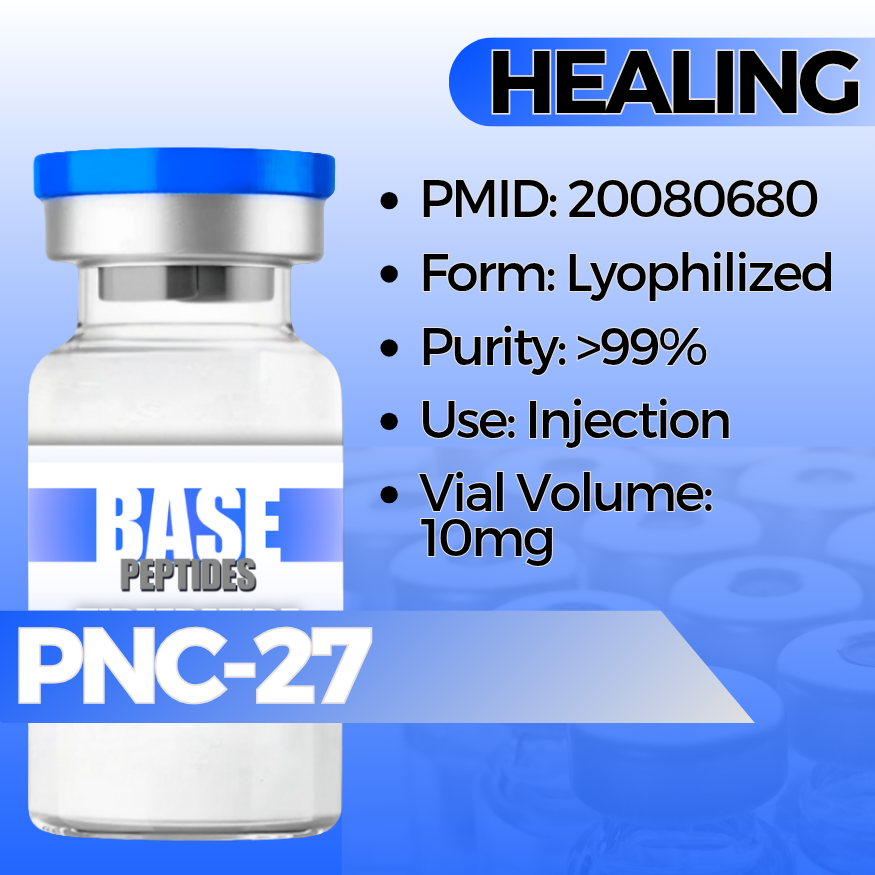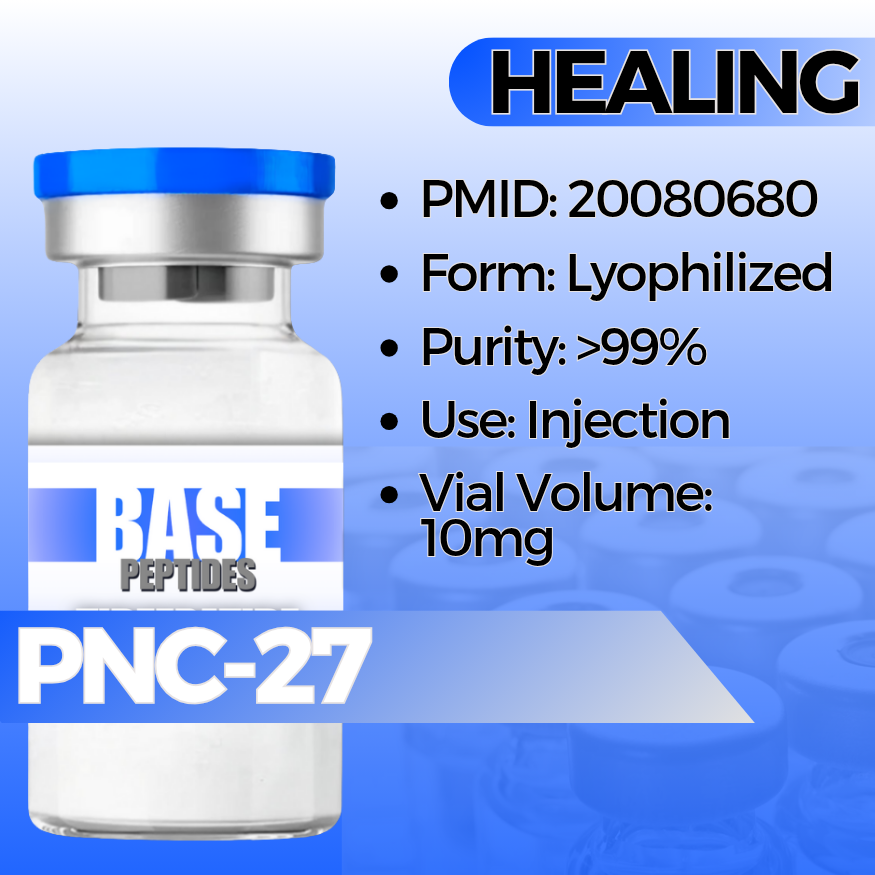PNC-27
PNC-27
Base Peptides are intended for licensed medical professionals and experienced researchers. Reconstitution required. Dosing and use instructions are not provided.
Couldn't load pickup availability
PNC-27 — p53(12–26)–Penetratin Chimeric Peptide (HDM-2–Targeting, Pore-Forming Senolytic-Like Agent)
PNC-27 is a chimeric peptide that joins the p53 residues 12–26 (the HDM-2/MDM2-binding domain) to a cell-penetrating leader sequence (penetratin/MRP).
In research models it binds HDM-2 present on cancer-cell membranes, assembling into complexes that form transmembrane pores and cause selective necrotic death of malignant cells while sparing untransformed cells.
-
Synonyms: p53(12–26)-penetratin peptide; PNC27
-
Sequence components: p5312–26 = PPLSQETFSDLWKLL; leader = RQIKIWFQNRRMKWKK (penetratin). Total length ≈ 32 aa.
-
CAS No.: 1159861-00-3
-
Typical MW / formula (supplier ref.): ~4031.7 Da; C188H293N53O44S.
- Target: HDM-2 (membrane-associated in malignant cells)
-
Finds HDM-2 on cancer-cell membranes and binds via the p53(12–26) motif.
-
Self-associates into pores with HDM-2 complexes → rapid membrane permeabilization and necrosis of malignant cells (“poptosis”).
- Spares normal cells in many models because untransformed cells lack membrane HDM-2.
- To study senescence/tumor burden reduction via selective killing of malignant or senescent-like cells.
- To probe HDM-2 biology at the plasma membrane and protein–protein interaction-derived pore formation.
- To contrast peptide senolytics with small-molecule approaches in fibrosis or solid-tumor models.
Key Study Themes — What Was Tested, What Changed, Why It Matters
Selective Killing of Cancer Cells
-
What was tested: Solid-tumor and hematopoietic cell lines ± PNC-27; parallel assays in normal/untransformed cells.
-
What changed: Preferential necrosis of malignant cells with little effect on normal cells, correlating with membrane HDM-2 presence.
- Why it matters: Supports HDM-2–dependent selectivity and motivates pore-forming mechanism studies.
Pore Formation & “Poptosis” Mechanism
-
What was tested: Imaging/biophysical assays (electron microscopy, dye-leakage, mitochondrial/lysosomal tracers).
-
What changed: Membrane pores lined by PNC-27/HDM-2 complexes; mitochondrial disruption observed in treated cancer cells.
- Why it matters: Differentiates necrotic pore-driven death from classic p53-apoptosis.
Fibrosis & Tissue Models (Exploratory)
-
What was tested: HDM-2/ECM signaling and myofibroblast endpoints in preclinical models.
-
What changed: Reduced myofibroblast markers and ECM deposition when senescent/aberrant cells were targeted.
- Why it matters: Suggests use as a tool compound in fibrosis biology alongside other senotherapeutics.
Potential Research Applications
Cancer Cell Biology
- HDM-2 membrane expression, pore-forming cytotoxicity, tumor selectivity assays.
Senescence / SASP Studies
- Clearance of senescent-like cells; cytokine/SASP profiling post-ablation.
Fibrosis & Remodeling
- ECM turnover, myofibroblast differentiation, organ-specific remodeling models.
Synergistic / Comparator Agents
FOXO4-DRI
- Why compare: Peptide senolytic via p53/FOXO4 dissociation (apoptosis) vs PNC-27 pore-driven necrosis.
Navitoclax (BCL-2 family inhibitor)
- Why compare: Small-molecule senolytic mechanism vs peptide HDM-2/membrane-pore approach.
Controls
- Penetratin alone or p53(12–26) alone to confirm requirement for the chimera.
What’s in the Vial
| Active | Per Vial | Grade / Purity |
|---|---|---|
| PNC-27 (p5312–26–penetratin chimera) | 10 mg (set per SKU) | Research-grade, ≥ 98–99% (HPLC/MS) |
| Appearance | White to off-white lyophilized powder | |
| Storage | Store ≤ −20 °C, desiccated; protect from light | |
Specifications & Handling
-
Reconstitution (lab use): Sterile aqueous buffer; record solvent, concentration, pH, and time-to-assay; avoid repeat freeze–thaw.
- Stability: Follow peptide-handling best practices; confirm identity/purity by HPLC/MS with each lot.
- Assay design: Include normal-cell controls (HDM-2 negative), dye-leakage/pore assays, and HDM-2 blocking where applicable.
Known Concerns (Context)
-
Translational status: Evidence is largely preclinical; limited human data.
-
Selectivity depends on target: Membrane HDM-2 expression varies by model; verify target presence to avoid off-target effects.
- General: For laboratory research use only; not for human consumption, medical, or veterinary use.
Regulatory & Use Notice
Sold for laboratory research use only. Not for human consumption, medical, or veterinary use. No human-use instructions are provided. Buyer is responsible for safe handling and regulatory compliance.
PNC-27 Research Peptide | p53(12–26)–Penetratin Chimera | HDM-2 Targeting, Pore Formation & Selective Tumor Cytotoxicity


